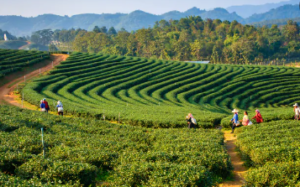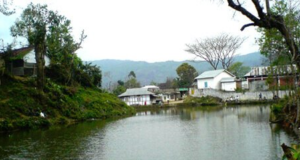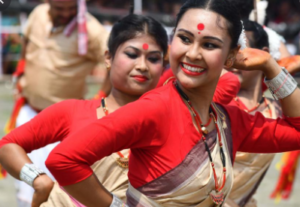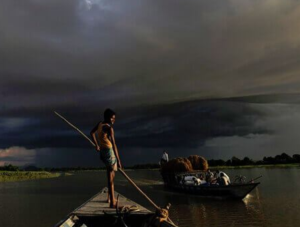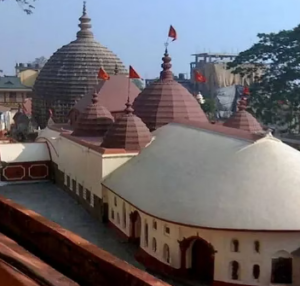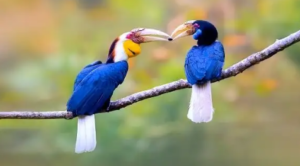Assam
Architecture & History
- Assam is the eastern province of India blessed with immense natural beauty and fresh scenery.
- The State is full of beautiful lush covers of green, a chain of hills and rivers mainly the Brahmaputra and the Barak.
- In the ancient Sanskrit literature both the names ‘Pragjyotisha’ and ‘Kamrupa’ were used as designation for ancient Assam.
- Prag means ‘former’ or ‘eastern’ and Jyotisha ‘a star’, astrology, shining. Pragjyotishpur may, therefore, be taken to mean the ‘City of Eastern Astrology’.
- The Ahom’s, Sukaphaa - a Shan prince of Mong Mao entered Assam after crossing the Patkai Mountains and ruled Assam for nearly six hundred years.
- The rule of this dynasty ended with the Burmese invasion of Assam and finally by the British East India Company following the Treaty of Yandaboo in 1826. The British emperor took charge of the state and thus begun the colonial era of Assam.
- Assam lost much of its territory to new states that emerged from within its borders.
- Assam became a separate province with capital, Shillong city.
- Due to heavy rainfall there are high chances of flooding in Assam. So, the houses are built on bamboo pillars called stilts, which are ten to twelve feet high to prevent water from entering the houses during floods.
- The “Assam type house” known as Ikra house that are earthquake proof is commonly found for living of the people of Northeast India. These houses are used for residential purposes. These houses are built with locally available materials like bamboos, leaves, wood planks and thatch.
- House in Assam are often a single storey. The second storey uses light wooden plank flooring in houses whereas other homes in rural areas have mud plastered floors.
Demographic Location
- Assam is known as one of the sisterly states of India. It is located in the northeastern part of the country.
- To the north lies the kingdom of Bhutan and the state of Arunachal Pradesh, to the east by the states of Nagaland and Manipur, to the south by the states of Mizoram and Tripura, and to the west by Bangladesh and the states of Meghalaya and West Bengal.
- The name Assam is derived from the word asama, meaning “peerless” in the now extinct Ahom language.
- The capital, of Assam is Dispur, a suburb of Guwahati.
- Assam, which is shaped roughly like a Y laid on its side, is a land of plains and river valleys.
- The Brahmaputra river rises as the son of the god Brahma from a sacred pool known as the Brahmakund, in neighbouring Arunachal Pradesh.
- The river enters Assam near Sadiya before turning south to enter the plains of Bangladesh.
- Numerous streams and rivulets that flow from the neighbouring hills empty fall in the Brahmaputra.
- The Brahmaputra and Barak valleys lie on ancient alluvial sediments, which themselves cover a variety of deposits from the Neogene and Paleogene periods.
- Among those deposits are hard sandstone, soft and loose sand, conglomerates, coal seams, shales, sandy clays, and limestone.
People, Rituals and Language
- Assam has been the living place of various races, tribes and ethnic groups since long time.
- Native Assamese people are called “Asomiya”, which is the same term used for their language. Assam is populated by several tribes that co-exist peacefully, follow their own traditions, culture, dress and exotic lifestyle.
- The largest tribe found in Assam are the Garo, the Kachari, the Khasi, the Lushai and the Mikir.
- Bihu festival is the most celebrated festival of Assam. The people of Assam celebrate this festival across the state with a great enthusiasm.
- Bihu dances are performed by young boys and girls to represent youthful passion, reproductive urge and joy. Dancers wear traditional colourful Assamese clothing.
- It is between 13th and 19th century that several tribal communities also came into the historical forefront of Assam. Kacharis, Chutias and Koch were the prominent tribal groups that were found in the medieval times of Assam.
- Kamarupa is found in literature as well as in many epigraphs. The origin of the name Kamarupa tells us the story of Sati who died due to the discourtesy shown to her husband by her father Daksha.
- With grief and anger, Shiva carried her dead body and wandered throughout the world. In order to put a stop Shiva, Vishnu used his Sudarshan discus to cut the body into pieces, which then fell into different places.
- One such piece fell down on Nilachal hills near Gawahati and the place was henceforth held sacred as Kamakhya. But Shiva’s did not calm down, so the Gods sent Kamdev, the cupid to calm him by making him fall in love.
- Kamdev succeeded in his mission, but Siva enraged at this result, burnt Kamdev to ashes.
- It is believed that Kamdev regained his original form here and the place got its name as Kamarupa.
- Assamese and Bodo are the official languages in Assam , whereas in some of the districts in the Barak Valley, Bengali enjoys the official status. Assamese is influenced in vocabulary, phonetics, and structure by people and culture speaking Tibeto-Burman dialects in the region.
Season & Climate
- There are four seasons in Assam - Summer, Monsoon, Autumn and Winter.
- The climate of Assam is typically 'Tropical Monsoon Rainforest Climate'. This climate has high level of humidity and heavy rainfall with a moderate climate all throughout the year, like warm summers and mild winters.
- Annual rainfall in Assam is not only the highest in the country but also ranks among the highest in the world.
- Average temperatures in Assam range from highs in the upper 90s F (about 36 °C) in August to lows in the mid-40s F (about 7 °C) in January.
- The cool season generally lasts from October to February and is marked by fogs and brief showers.
Famous Spots
Kaziranga National Park
Wide range of exotic animals such as Chinese pangolins, one-horned rhinoceros, Bengal foxes, Bengal Tigers, swamp deer and more have been the home since long time.
Majuli Island
One of the world's wonderful river islands. Often during monsoons, a significant part of the island submerges underwater.
Orang National Park
Orang National Park with splendid greenland and its flourishing flora and fauna. The national park offers splendid view of the River Brahmaputra's shores.
Haflong Lake
The Lake is surrounded by mountains. The lake is a place where some playful activities such as boating, fishing, water sports are enjoyed.
Kamakhya Temple
The deities of the Kamakhya temple are Lord Shiva and Daksha Yagna. The Hindu temple is also famous for its Tantric activities and fiction stories.
Umananda Island
The place is a lovely island also know as Peacock Island. The island is surrounded by the Brahmaputra River on all sides with one temple dedicated to Lord Shiva.
Panimoor Falls
Another place likes for its wonderful natural beauty.
Aqua-Life, Flora & Fauna
- Almost one-third of Assam is covered with various types of woodlands, including tropical evergreen and deciduous forests, broad-leaved hill forests, pine forests, and swamp forests, grasslands.
- Assam has been the home to some several species of trees, many of which have commercial value. Sal and hollong trees are among the most valuable of the hardwoods. Bamboo, orchids, and ferns also are abundant.
- Kaziranga National Park, is famous for Assam Elephants and Rhinocerous.
- World heritage under UNESCO is the Kaziranga National Park, situated on the bank of the river Brahmaputra. The Manas Wildlife Sanctuary situated near the border with Bhutan.
- This area is breading place for the fast-disappearing Indian one-horned rhinoceros, tigers and leopards are found in abundance here.
- Other wild life inhabitants of Assam’s forests are gaurs, wild pigs, various species of deer, and primates, like langurs and hoolock gibbons.
- Birds found are cormorants, herons, ducks, and other water birds, warblers, thrushes, owls, and peacocks. Hornbills are characteristic of Assam, although they are endangered in some areas.
- The state is the inhabitat of reptiles, including poisonous snakes, such as kraits, cobras, and vipers; a wide variety of lizards, skinks, and geckos; and many types of turtles.
- Assam is known for its high quality of tea and coffee which is in high demand in many developed countries.

